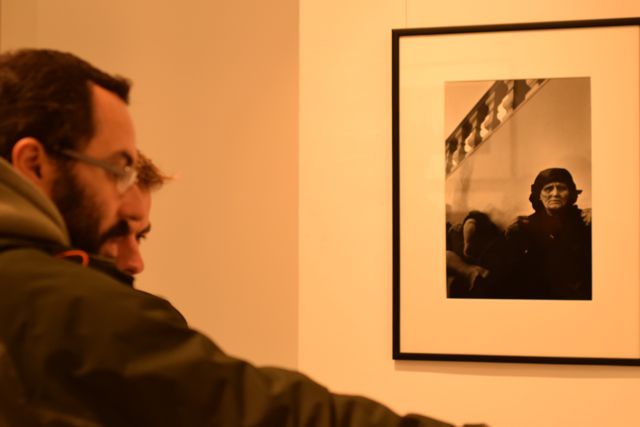Photos: the author
Polina Spartyanova
John Demos was born in Thessaloniki in 1944, but his father and his parents were born in the Bulgarian city of Plovdiv, which John calls "Philippopolis". It is where he showed his world-famous project "Shadows of Silence" for the first time in Bulgaria. He had taken the photographs in the 1980s, gathering documentary evidence of religious scenes from small provincial towns throughout Greece in order to study human spirituality and faith. The second stop of the collection is in Sofia gallery for photography "Synthesis", where GRReporter met with one of the most popular Greek photographers.
 How long did it take you to make the collection "Shadows of Silence"?
How long did it take you to make the collection "Shadows of Silence"?
It took 10-12 years to develop the exhibition and it contains even photographs from another project that I developed in the 1970s. When I returned from the United States after completing my studies there, I saw that Greece was changing too much and compiled a book about what was happening at the time. I started in 1970-75 and continued until the early 1990s.
The way I work is a bit crazy, because I take pictures all the time, wherever I go. I do not even see my work for long after I have completed it because I use the analogue format and I have only recently ventured into the digital. Frankly speaking, I do not think that I will work with it for long, for example, in Plovdiv, where I want to definitely go back and finish my work because I want to do much more and I love the city very much. Probably you will not see over the following few years the photographs that I have taken there. I have such a philosophy, which differs from that of other photographers in that they want to get the job done as quickly as possible and to immediately show it whereas mine is different. I prefer to allow my work to mature, like a good wine, and then to see what is good and what not so much. There is another reason to do this because the type of photography that interests me is not an instant sensation. I want my photographs to have a lasting impact and to draw interest in other times. It is also associated with the objects I choose for my work. For example, "faith" can be seen in this project, some people can see religion in it but I am interested in how people believe and how they agonize to believe, not so much in their religion. I am not interested in their religion. If you combine this with the way I work, it will make sense to you.

What lies behind the black-and-white contours of your collection?
I think it makes no sense to explain the philosophy of the exhibition. The photographs either tell you something or do not. Therefore, a closer scrutiny will reveal what the photographs tell. There is a whole realm of perceptions in my collection - there are some people who believe, others who doubt faith, and there is a tragedy sometimes. If I begin to explain the photographs, it would not make sense to display them in this way and to present them to the public.
Have you visited Bulgaria on a previous occassion?
I came to Bulgaria before to take photographs for French newspaper "Le Monde", then for French magazine "Liberation" and for an American magazine, when I went to take photographs of Kozloduy Nuclear Power Plant because there was a false alarm for a problem in it and the accident in Chernobyl had occurred only a few years earlier. However, I like Bulgaria very much and I feel very comfortable here, I like the people and I have to find some occasions to come back here more often and to take photographs.
Do you feel connected with Bulgaria in any way, especially because of the history of your ancestors?
Yes, yes, I feel very connected to Philippopolis, because my father was born there and I have heard many stories from my grandfather. After World War I, there was a population exchange between Bulgaria and Greece and my father's family had to return to Thessaloniki, and many Bulgarians had to come back here. They were Greeks at the time when Plovdiv was called Philippopolis. I had an aunt in Plovdiv, but I think she died and I remember my mother going to visit our relatives while she was still alive.